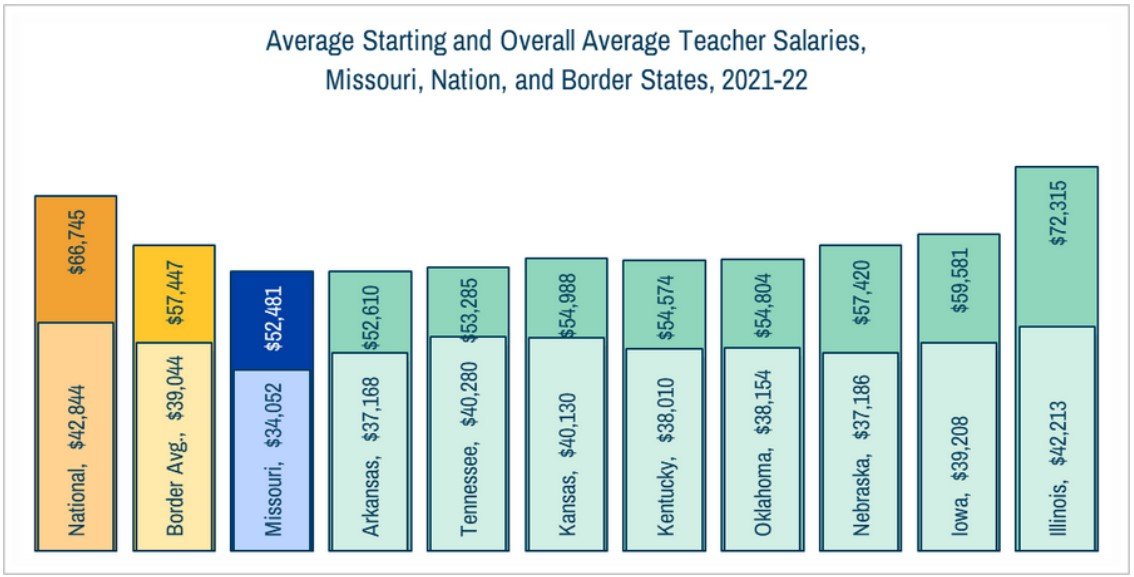Missouri Teacher Workforce Trends
By Duncan Carson
Published On: July 20, 2023
First-year Missouri educators earned just over $34,000 on average for the 2021-22 school year, ranking second-lowest in the nation for average starting teacher pay. Missouri’s 2021-22 average teacher salary was also among the lowest in the country, and less than average teacher pay in all eight border states.
These low teacher salaries may hinder districts’ recruitment efforts. According to our 2021 analysis of the relationship between teacher salaries, four-day school week implementation, and teacher recruitment in Missouri, higher salaries helped districts recruit quality teachers regardless of four-day weeks.
Furthermore, the pool of new teachers that districts recruit from is shrinking, as data from our recent Missouri Education Profile seems to show a leaking teacher pipeline. The number of new teacher certificates issued by the state fell 16% between 2016 and 2022. Over a slightly wider period, increases in the number of new candidates in teacher preparation programs (i.e. enrollees in an education degree program) failed to translate to more program completers (i.e. graduates receiving an education degree); this latter group shrank 13% between 2014 and 2021.
From this shrinking pool, however, Missouri districts were still able to find more new teachers. For the 2021-22 school year, districts statewide hired more teachers than they had in any of the last five years.
This hiring increase came as the state budget introduced a grant program designed to raise minimum teacher salary to $38,000. (For comparison, a $38,000 average starting teacher salary would move Missouri up to 39th place in national pay rankings, on par with Oklahoma, where starting teachers make $38,074 on average.)
According to the state’s Department of Elementary and Secondary Education, this grant program was poised to benefit roughly 8,500 teachers statewide. 6,300 teachers ultimately received support from the 2021-22 grants, which covered 70% of the cost associated with raising minimum teacher salaries so long as districts found the last 30% in local funds. This year’s iteration of the grant program drops the local matching requirement, and will be open for applications until July 31st.
School staffing shortages were also an issue for the most recent Missouri legislative session. Senator Rusty Black, R-Chillicothe, introduced a bill allowing retired educators to temporarily return to districts (for up to four years) without losing retirement benefits. This bill, which goes into effect August 28th, will also raise the earning cap for retirees returning to work in non-certificated school positions, like bus drivers and janitors.
Of course, recruitment and retirement are not the only two levers for influencing teacher supply. Overall teacher retention was at its lowest rate in Missouri (88.1%) in 2021-22 as compared to the five years previous. To try and understand the climate and culture teachers face in Missouri, the Teacher Recruitment and Retention Blue Ribbon Commission surveyed teachers across the state. A majority of teachers said the 2021-22 school year was more stressful than the last.
The most popular non-traditional benefit proposal for surveyed teachers was paid time off for wellness days. The PRiME Center is interested in providing a research context for teacher paid time off and work flexibility, especially as it relates to parental leave, in our future work.
The PRiME Center is excited to follow recent changes in teacher pay and benefit availability and will continue to publish accessible summaries of these trends. To read more about Missouri’s teacher workforce in the 2021-22 school year, or to learn about a variety of education topics for this first full year in-person following the COVID-19 pandemic, get our full 2023 Missouri Education Profile below.







This week in neighboring Illinois, a bill to ban cell phones from classrooms unanimously passed in the Senate. The bill, advocated for by Illinois’ Governor J.B. Pritzker, now moves to the House. If passed, they would join the more than 40% of states who have laws or policies restricting cell phone use in schools. Missouri has similar legislation in the works, and voters are in support.